Telstra Bundle
Can Telstra Maintain Its Dominance in the Dynamic Telecoms Sector?
Telstra, a cornerstone of Australia's telecommunications landscape since 1901, has continuously adapted to technological shifts, making it a compelling case study in strategic growth. Its journey from connecting Australians to leading in mobile, internet, and digital solutions showcases the power of a forward-thinking approach. This analysis examines the Telstra SWOT Analysis, its strategic initiatives, and financial performance to understand its future trajectory.
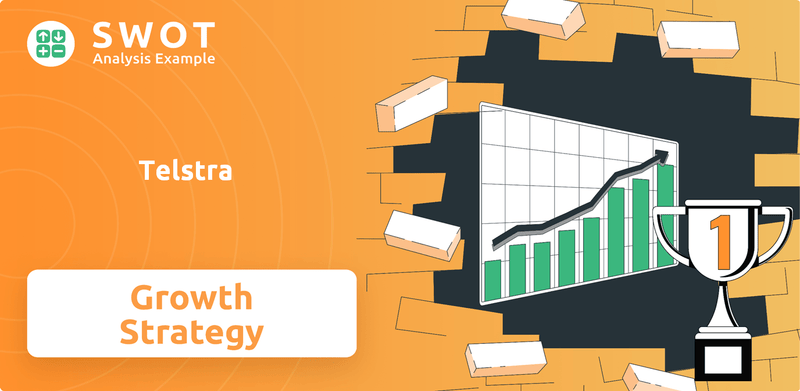
This comprehensive Telstra company analysis explores the company's growth strategy, examining its expansion into new markets and investment in infrastructure, particularly its 5G capabilities. We'll delve into Telstra's future prospects within the telecommunications industry, assessing its business model and competitive advantages. Understanding Telstra's long-term growth plan, revenue growth drivers, and sustainability initiatives is crucial for investors and strategists alike, particularly in the context of the company's digital transformation strategy and its impact on the Australian economy.
How Is Telstra Expanding Its Reach?
The company is actively undertaking several expansion initiatives to reinforce its market position and diversify revenue streams. A core focus involves the expansion of its 5G network, targeting 95% population coverage by mid-2025. This strategic move aims to attract new customers and enhance service quality across urban and regional areas, solidifying its competitive edge in mobile services. This demonstrates a proactive approach to maintaining and growing its Telstra's mission.
Furthermore, the company is investing in its Fibre to the Node (FTTN) network, with plans to upgrade connections for over 1 million premises by the end of 2025. This upgrade is designed to improve broadband speeds and reliability, catering to the increasing demand for high-speed internet services. These initiatives are critical to the company's long-term growth plan and its ability to compete effectively in the telecommunications industry.
Beyond network infrastructure, the company is exploring new product categories and business models. The company is actively pursuing opportunities in the growing digital solutions and managed services segments for businesses, leveraging its expertise in connectivity and technology. This expansion into adjacent digital services is a key component of the company's digital transformation strategy.
The company is focused on expanding its 5G network. The goal is to achieve 95% population coverage by mid-2025. This expansion is vital for maintaining its competitive edge in mobile services and capturing new customers. This is a key aspect of its Telstra growth strategy.
The company plans to upgrade connections for over 1 million premises by the end of 2025. These upgrades will improve broadband speeds and reliability. This investment is crucial for meeting the growing demand for high-speed internet.
The company is exploring opportunities in digital solutions and managed services for businesses. This expansion leverages its expertise in connectivity and technology. This is a key area for diversifying revenue streams.
The company often collaborates with technology providers to enhance its service offerings. An example is the ongoing work with Ericsson on 5G standalone (SA) technology. These partnerships are important for innovation.
The company's expansion strategy focuses on several key areas to drive growth. These initiatives are designed to enhance service offerings and capture new market opportunities. These efforts are critical for the company's future prospects.
- 5G network expansion to reach 95% population coverage by mid-2025.
- FTTN network upgrades to improve broadband speeds and reliability.
- Expansion into digital solutions and managed services for businesses.
- Strategic partnerships to enhance service offerings and drive innovation.
Telstra SWOT Analysis
- Complete SWOT Breakdown
- Fully Customizable
- Editable in Excel & Word
- Professional Formatting
- Investor-Ready Format
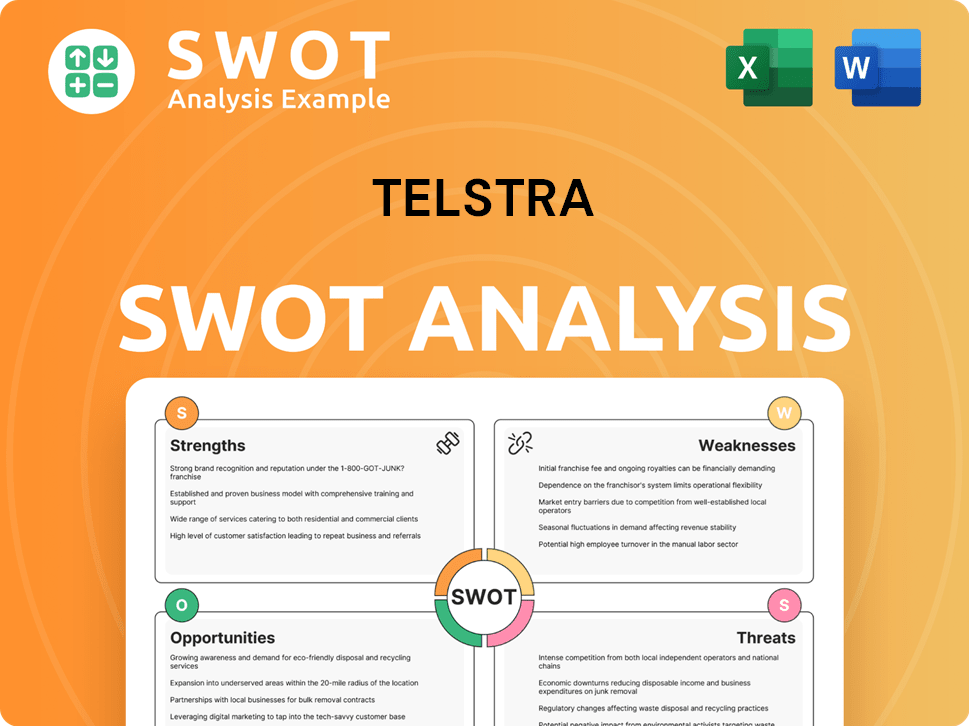
How Does Telstra Invest in Innovation?
The Telstra company analysis reveals that its growth strategy heavily relies on innovation and technology. This approach is crucial for maintaining its competitive edge in the rapidly evolving telecommunications industry. By investing in cutting-edge technologies, the company aims to enhance its service offerings and improve operational efficiency.
Telstra's future prospects are closely tied to its ability to adapt and integrate new technologies. This includes the deployment of 5G, advancements in IoT, and the implementation of network virtualization. These initiatives are designed to meet the growing demands of consumers and businesses alike.
Telstra's focus on digital transformation is a key element of its strategy. This involves automating network operations, improving customer experiences, and developing new digital platforms. The company is also exploring the use of AI to optimize network performance and enhance cybersecurity.
Telstra is actively expanding its 5G network across Australia. As of late 2024, its 5G network covers a significant portion of the population, with ongoing expansion plans.
Telstra is investing in IoT solutions to cater to various industries. This includes smart city projects, connected vehicles, and industrial automation. The company aims to leverage IoT for revenue growth.
Telstra is implementing network virtualization to enhance its network's flexibility and efficiency. This allows for faster service deployment and improved resource utilization.
The company is integrating AI and automation to optimize network operations and enhance customer service. This includes AI-driven network management and chatbots for customer support.
Telstra is developing new digital platforms to improve customer experiences and offer innovative services. This includes online portals and mobile applications for managing accounts and accessing services.
Telstra is committed to sustainability, focusing on reducing energy consumption and carbon emissions. This includes using renewable energy sources and optimizing network infrastructure for energy efficiency.
Telstra's technological advancements are directly contributing to its growth objectives. These advancements enable new products, improve operational efficiency, and create differentiated customer experiences. The company's continuous upgrades to its network infrastructure, including the ongoing deployment of its 5G network and FTTN upgrades, underscore its commitment to maintaining a technological advantage. These investments are crucial for sustaining Telstra's market share and driving Telstra's revenue growth.
Telstra's technology strategy encompasses several key areas, including 5G, IoT, and digital transformation. These initiatives are designed to enhance its competitive position and drive future growth. Strategic partnerships and significant investments in infrastructure are crucial.
- 5G Deployment: Expanding 5G coverage across Australia, with a focus on both urban and regional areas.
- IoT Solutions: Developing and deploying IoT solutions for various industries, including smart cities and connected vehicles.
- Digital Transformation: Automating network operations and enhancing customer digital experiences through new platforms.
- AI Integration: Utilizing AI to optimize network performance, personalize customer interactions, and improve cybersecurity.
- Network Virtualization: Implementing network virtualization to increase flexibility and efficiency.
Telstra PESTLE Analysis
- Covers All 6 PESTLE Categories
- No Research Needed – Save Hours of Work
- Built by Experts, Trusted by Consultants
- Instant Download, Ready to Use
- 100% Editable, Fully Customizable
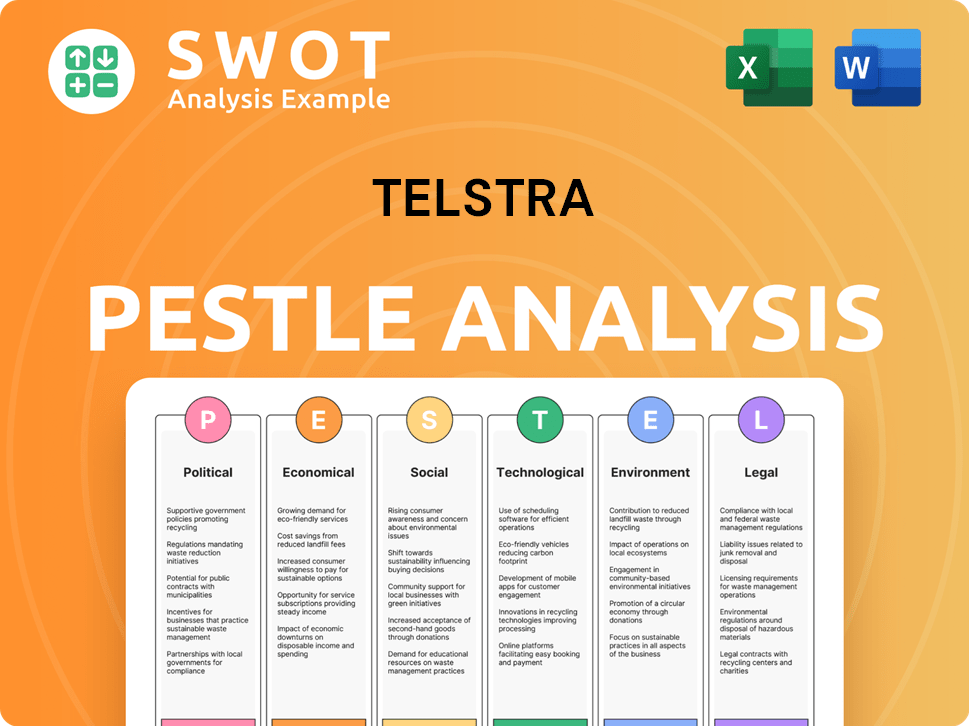
What Is Telstra’s Growth Forecast?
The financial outlook for Telstra is shaped by its strategic focus on growth, supported by careful capital management and a commitment to delivering sustainable returns. For the initial half of the 2024 fiscal year, Telstra reported a total income increase of 1.1%, reaching $11.7 billion, with a net profit after tax (NPAT) of $825 million. This performance underscores the company's ability to maintain financial stability while investing in future growth.
Telstra's guidance for the full financial year 2024 anticipates total income to be between $22.6 billion and $23.6 billion, and underlying EBITDA to range from $8.2 billion to $8.4 billion. These projections highlight Telstra's confidence in its operational strategies and its capacity to navigate the evolving telecommunications landscape. The company's financial performance is critical to understanding the Telstra growth strategy and its overall Telstra company analysis.
Telstra's financial strategy is designed to support its significant investments in network infrastructure and expansion efforts. The company's capital expenditure for FY24 is planned to be between $3.6 billion and $3.7 billion. This investment is crucial for maintaining its competitive edge and capitalizing on emerging opportunities in the market. The company's focus on Telstra future prospects is clear through its strategic investment decisions.
Telstra's financial results for the first half of FY24 demonstrate a solid performance. Total income grew by 1.1% to $11.7 billion. This growth is a key indicator of the company's ability to generate revenue in a competitive market. The company's financial performance is crucial for understanding its Telstra business model.
Telstra has provided clear guidance for the full financial year 2024. The company expects total income to be between $22.6 billion and $23.6 billion. Underlying EBITDA is projected to be between $8.2 billion and $8.4 billion. These figures are important for assessing Telstra's financial performance.
Telstra's planned capital expenditure for FY24 is between $3.6 billion and $3.7 billion. This investment is primarily focused on network infrastructure and expansion initiatives. These investments are crucial for Telstra's investment in infrastructure.
Telstra's strategic investments are aimed at expanding its market share and driving efficiency through digital transformation. These investments are designed to ensure sustained revenue growth. This is a key part of Telstra's long-term growth plan.
The company maintains a focus on consistent dividend payouts, which is a key part of its financial strategy. This approach helps to provide value to shareholders. The company is focused on Telstra's revenue growth drivers.
Telstra aims to expand its market share in key segments. The company is also focused on driving efficiency through digital transformation. The company is working on Telstra's digital transformation strategy.
Telstra Business Model Canvas
- Complete 9-Block Business Model Canvas
- Effortlessly Communicate Your Business Strategy
- Investor-Ready BMC Format
- 100% Editable and Customizable
- Clear and Structured Layout
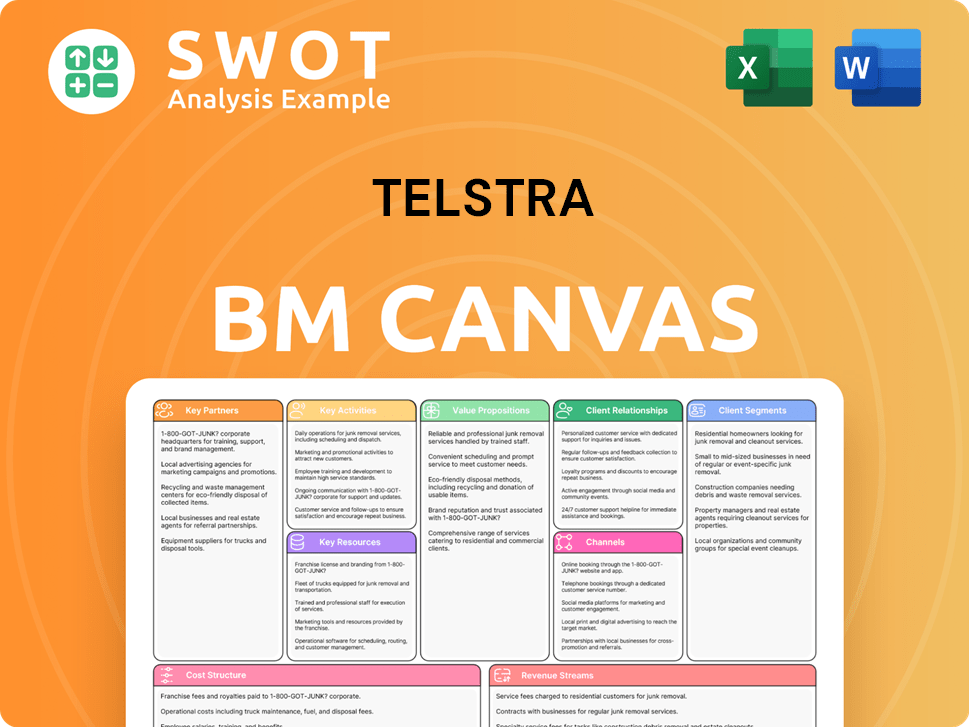
What Risks Could Slow Telstra’s Growth?
The growth trajectory of Telstra is subject to several risks and obstacles. The competitive landscape in the Australian telecommunications market, along with regulatory changes, could significantly affect the company's performance. Understanding these challenges is crucial for a comprehensive Telstra company analysis.
Technological advancements and supply chain issues also pose potential threats. Failure to adapt to new technologies or disruptions in the supply chain could hinder Telstra's growth. These factors need careful consideration when evaluating Telstra's future prospects.
Intense competition from companies such as Optus and Vodafone presents a continuous challenge. Telstra's market share and pricing power are constantly under pressure. Regulatory changes, particularly from the Australian Competition and Consumer Commission (ACCC), can also create operational hurdles. For a deeper dive, consider Telstra's Target Market.
The telecommunications market in Australia is highly competitive, with major players like Optus and Vodafone vying for market share. This competition impacts Telstra's ability to maintain its customer base and pricing strategies. The ongoing battle for customers necessitates innovative service offerings and competitive pricing.
Regulatory changes, especially those concerning spectrum allocation and network access, can significantly influence Telstra's operations. The ACCC's decisions and rulings can directly affect Telstra's profitability and strategic initiatives. Compliance with evolving regulations requires continuous adaptation and investment.
Rapid technological advancements present both opportunities and risks. Telstra must swiftly adapt to emerging technologies like 5G and potential disruptions from new market entrants. Failure to do so could erode its competitive advantage and market position. The company's digital transformation strategy is key here.
Supply chain issues, particularly regarding network equipment and components, can impact network deployment timelines and costs. Disruptions in the supply chain can delay infrastructure upgrades and expansions, affecting Telstra's ability to meet growing customer demands. Diversification of suppliers is crucial.
Increasing cybersecurity threats pose a significant risk to Telstra's operations and customer data. Protecting against cyberattacks requires substantial investment in security infrastructure and proactive measures. Data breaches can lead to financial losses and reputational damage.
Maintaining network superiority requires significant ongoing capital expenditure. Upgrading and expanding its network infrastructure to support new technologies and increasing data demands involves substantial financial commitments. This continuous investment is vital for long-term growth and competitiveness.
Telstra employs a multi-faceted approach to mitigate these risks. This includes diversifying its service offerings, implementing robust risk management frameworks, and actively engaging with regulators. The company's past experiences in navigating market changes and regulatory landscapes demonstrate resilience. These strategies are vital for maintaining Telstra's competitive edge and achieving its long-term growth plan.
Telstra's financial performance is influenced by its ability to manage these risks. Key metrics to watch include revenue growth, profitability, and market share. In recent years, Telstra has focused on improving its financial performance through strategic initiatives and cost-cutting measures. Understanding these financial aspects is crucial for a comprehensive Telstra company analysis 2024.
Telstra Porter's Five Forces Analysis
- Covers All 5 Competitive Forces in Detail
- Structured for Consultants, Students, and Founders
- 100% Editable in Microsoft Word & Excel
- Instant Digital Download – Use Immediately
- Compatible with Mac & PC – Fully Unlocked
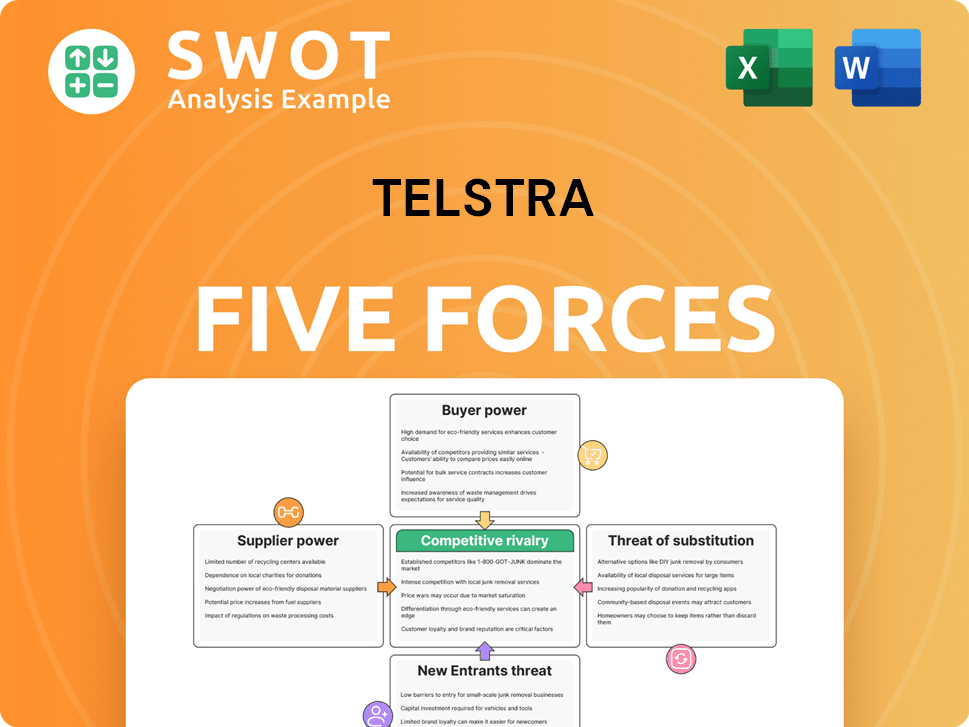
Related Blogs
- What are Mission Vision & Core Values of Telstra Company?
- What is Competitive Landscape of Telstra Company?
- How Does Telstra Company Work?
- What is Sales and Marketing Strategy of Telstra Company?
- What is Brief History of Telstra Company?
- Who Owns Telstra Company?
- What is Customer Demographics and Target Market of Telstra Company?
Disclaimer
All information, articles, and product details provided on this website are for general informational and educational purposes only. We do not claim any ownership over, nor do we intend to infringe upon, any trademarks, copyrights, logos, brand names, or other intellectual property mentioned or depicted on this site. Such intellectual property remains the property of its respective owners, and any references here are made solely for identification or informational purposes, without implying any affiliation, endorsement, or partnership.
We make no representations or warranties, express or implied, regarding the accuracy, completeness, or suitability of any content or products presented. Nothing on this website should be construed as legal, tax, investment, financial, medical, or other professional advice. In addition, no part of this site—including articles or product references—constitutes a solicitation, recommendation, endorsement, advertisement, or offer to buy or sell any securities, franchises, or other financial instruments, particularly in jurisdictions where such activity would be unlawful.
All content is of a general nature and may not address the specific circumstances of any individual or entity. It is not a substitute for professional advice or services. Any actions you take based on the information provided here are strictly at your own risk. You accept full responsibility for any decisions or outcomes arising from your use of this website and agree to release us from any liability in connection with your use of, or reliance upon, the content or products found herein.